
As a boy growing up in Ireland, I looked forward to only one thing, come autumn, more than Christmas itself: my mother's Christmas pudding—a moist, dense mixture of suet, bread crumbs, eggs, stout, brandy, and dried fruit, all spiked with cinnamon and nutmeg and steamed in a mold. Once known as plum pudding, that dish hasn't always been a holiday dessert. English recipes from the 15th century call for the dried fruit (generally referred to as plums) to be mixed with minced meat, then boiled in the stomach lining of a sheep. As spices, sugar, and alcohol became more accessible in the British Isles, a sweeter, alcoholic version developed that was savored at Christmas.
Traditionally, the specialty is prepared at least a month in advance so that the flavors can meld together, although some people prefer the distinct flavors of a fresh pudding. My mother was of the former camp. Each November, I'd eye the plump raisins and candied lemon peel that she tossed into her mixing bowl. After the pudding had steamed, I'd beg for a taste, but she'd keep it hidden until Christmas. Today my wife and I run a food shop in the Irish countryside, and in the fall, the scent of Guinness and nutmeg wafts through our store as we make puddings for our customers. By December, we'll have eaten ten of them, and our children will have stolen a few tastes too.
Keep Reading
Continue to Next Story










